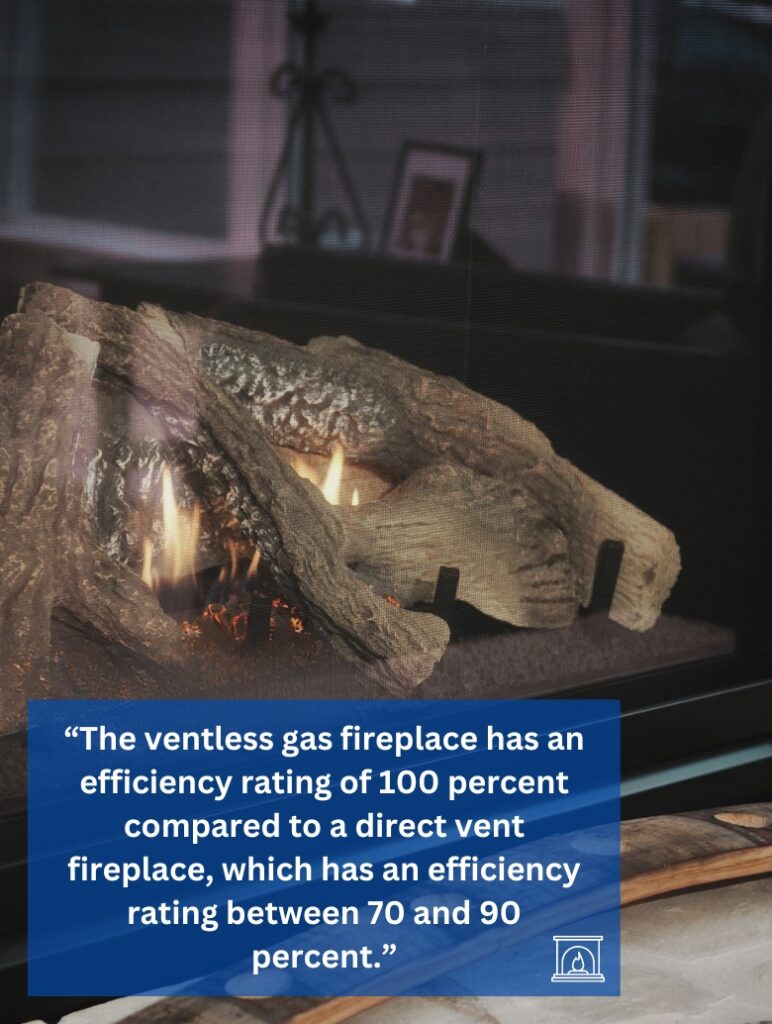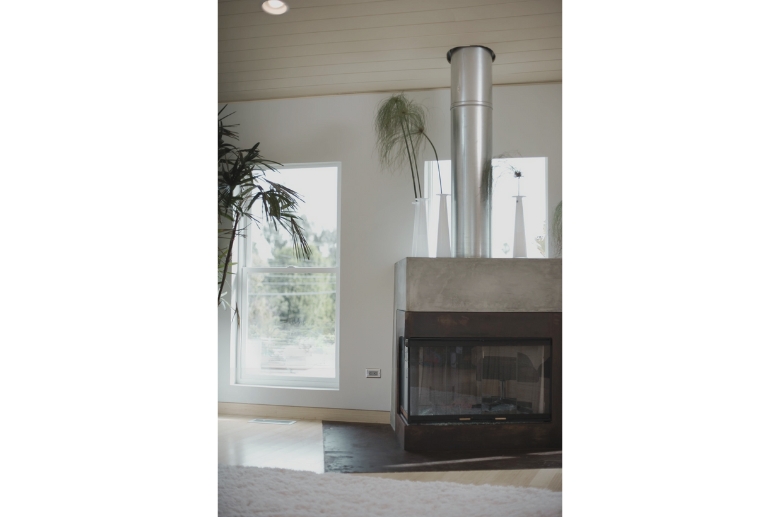When it comes to deciding what is the most efficient type of gas fireplace, there are two options to choose from: direct vent and ventless.

The ventless gas fireplace has an efficiency rating of 100 percent compared to a direct vent fireplace, which has an efficiency rating between 70 and 90 percent.
Aside from efficiency, gas fireplaces are becoming the preferred home heating method because they produce fewer emissions compared to a wood fireplace.
What Is the Most Efficient Type of Gas Fireplace?
The ventless gas fireplace is designed similarly to a high-efficiency gas furnace. Combustion gasses are recycled inside the closed firebox, allowing for more heat to be extracted from the fuel. The firebox also serves as a built-in catalytic converter that removes harmful emissions.
You might hear a ventless gas fireplace referred to as a flueless fireplace. As the name suggests, this type does not require a flue or chimney. Because of this, you can put it anywhere in your home.
However, keep in mind that the room should be big enough for sufficient air to create a strong flame. A room that is at least 30 cubic meters is enough for a ventless gas fireplace to work.
The second most efficient among the different gas fireplace types is the direct vent or vented fireplace. In this fireplace, the firebox is connected to a vent or flue system that filters away combustion gases. It also draws in fresh air from outside to keep the fire burning at the right temperature.
——
Do You Need to Hire Chimney & Fireplace Expert?
Get free quotes from qualified experts near you. No commitment required!
——
Factors That Affect Gas Fireplace Efficiency
Aside from the type of gas fireplace, several other factors could affect its efficiency. Look into these as well so you can get the most out of your fireplace.
- BTUs – Both ventless and direct vent gas fireplace units can have the same BTUs. However, a direct vent type will lose more heat because the gas escapes up and out of the chimney. If you’re talking about which has better BTUs, ventless gas fireplaces are the top option.

- Fireplace Design – Gas fireplace products come in a variety of designs. You can pick a style that best suits your home’s interior. When it comes to efficiency, you’ll need one that is appropriately sized for the room. This can be difficult because, aside from measuring square space, you also have to measure the height of the room. It’s best to get a local expert with experience who can come in and measure your home. They’ll be able to give you proper recommendations for a fireplace system with the right BTUs.
- Venting System – Venting systems can greatly impact a fireplace’s efficiency. You lose some heat because it escapes through the vent. Incorporating a gas fireplace with a blower can mitigate some of the heat loss associated with vented systems. On the other hand, a ventless fireplace unit recycles air within the room, making it very efficient.
- Insulation – To get the best efficiency out of your gas fireplace, improve the insulation in the house. It can help prevent heat loss and keep the warmth from your fireplace inside your home.
Check the areas around your fireplace to make sure there are no gaps or cavities in the walls. Pay special attention to the joints between the fireplace and the walls, as well as in the chimney and vents, as this is where air leaks often happen.
Use insulation materials like fiberglass and fire-resistant insulation boards to fill these gaps. For small cracks, use a heat-resistant sealant. In addition, you can use insulated glass doors to help retain heat.
Direct Vent vs. Vent-Free Fireplace: Pros and Cons
Let’s examine the differences between direct vent and vent-free fireplaces, their efficiency ratings, and their advantages and disadvantages.
Direct Vent Gas Fireplaces

This type is connected to a flue, which draws air from the outside to provide combustion and is also where combustion gases escape.
Direct vent gas fireplace efficiency rating: 70% to 90%
Advantages
- Flexible installation: it can be installed horizontally and vertically.
- Helps maintain indoor air quality.
- It can be used without electricity.
- No oxygen sensor is required.
- Less water vapor is produced.
Disadvantages
- Installation can be complex.
- Needs to be installed on a wall that vents outdoors.
- More heat loss.
- More maintenance.
Ventless Gas Fireplaces

This type of fireplace has no flue, but it’s specially designed with a catalytic converter, so it burns clean. It also has an oxygen-depletion sensor, which automatically turns the fireplace off if it detects that a room’s oxygen level is below 18%.
Ventless gas fireplace efficiency rating: 99%
Advantages
- Highly energy efficient.
- Burns very cleanly.
- It is easy to install anywhere in the home, including on interior walls.
- No venting is required.
- More affordable than direct gas fireplaces.
- Less maintenance.
Disadvantages
- It can impact air quality inside the home.
- It cannot be used without electricity.
- Potential moisture buildup.
- Strict installation requirements.
- Not permitted in all areas.
Choosing the Most Energy Efficient Gas Fireplace For Your Home
A gas fireplace can be used without electricity, so it is sure to provide the efficiency you need. It also does not require a chimney like most wood-burning fireplaces.
You can control it with a remote or thermostat, and it’s easy to turn it off immediately. Gas fireplaces are also preferred because they emit less particulate matter. Thus, you don’t have to worry about harmful emissions affecting the indoor air quality of your home spaces.
Several other factors might affect your decision when choosing a gas fireplace for your home. In addition to efficiency, consider cost, maintenance, and safety. Let’s examine each factor.
——
Do You Need to Hire Chimney & Fireplace Expert?
Get free quotes from qualified experts near you. No commitment required!
——
Cost and Budget
The ventless gas fireplace system is the cheapest to install because it does not require a venting pipe. Installation costs can range from $2,000 to $3,500.
The cost of installing a direct vent fireplace is significantly higher. Aside from the fireplace itself, which can cost between $1,000 to $10,000 depending on the size, shape, and features, you also need to factor in the cost of venting pipe, installation, and labor.
The average cost of installing a direct-vent fireplace ranges between $4,200 and $11,500. In terms of use, a ventless fireplace is more cost-effective because it’s more energy efficient.
Maintenance Requirements
For your gas fireplace to work efficiently and look good in your home, you’ll need to clean it regularly, at least once a month. Part of the process includes removing dust, debris, and other grime from the fireplace.
If the fireplace has a vent, factor that into the maintenance. It has to be inspected to make sure there are no obstructions. You also need to ensure there is no soot buildup in the vent walls, so a regular chimney sweep is required at least once a year.
Safety Considerations
Despite being the obvious choice in terms of efficiency, a ventless gas fireplace is considered the riskier option. In fact, it is prohibited in some states, like California. That’s because it has the potential to release small amounts of combustion gases, which can negatively impact the indoor air quality in your home.
Ventless fireplaces also release water vapor, which can impact a room’s humidity. It can encourage mold growth and deteriorate your drywall and woodwork.
Before installing a ventless fireplace, check the regulations in your area to make sure it is allowed.
Direct-vent fireplaces are much safer. They prevent harmful gases like carbon monoxide and nitrogen dioxide from entering your home, ensuring peace of mind and good indoor air quality.
When to Get Professional Help
If you’re still deciding what type of gas fireplace to get, it might help to consult with a professional. They are experienced in weighing the pros and cons of each type based on your location, room size, and other preferences.
It’s also a good idea to let a professional do the installation for you. They understand the building codes you need to follow. Most states also require that you hire an installer with a license to handle gas lines.
Conclusion
Both direct vent and ventless gas fireplaces are energy efficient. However, if maximum efficiency is important to you, a ventless gas fireplace is the perfect choice. It’s cheaper, easier to install, burns clean, and easily maintained.
However, strict regulations can prevent you from installing one in your home. It’s best to contact a professional to help you with this. They’ll be able to install it according to state regulations and provide information on how you can run your ventless fireplace safely all year round.






